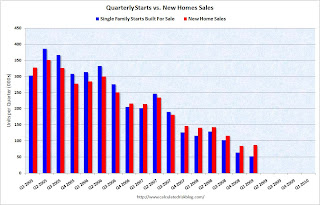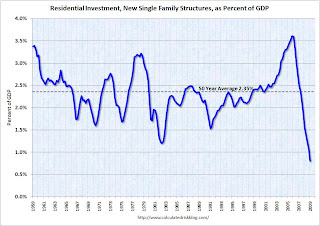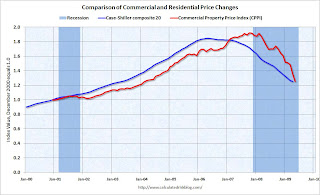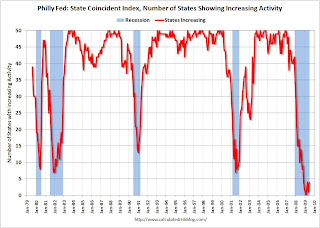タイムラグが出来ており、先週のニュースですが。
----------------------------
6月の米住宅着工件数は+3.6%となり、一戸建て住宅着工件数が押し上げたという。※2に詳しい分析があるが、着工件数統計の中の"Single Family Starts, Built for Sale")は過去6か月新築戸建住宅販売数を下回っており、着工件数としては本格的に底入れした可能性がある。
ただ、以前から何度も言っている様に、価格的にはまだ高く、市場に巨大な在庫が残っている現状では、早急な価格面での底入れは望めない。価格面での底入れまでは、資産価値へのマイナスの影響は残る。
といっても、住宅着工件数の底入れには良い面もある。
GDPに占める住宅投資("Residential Investment")の割合は、2006~2007年ごろのピーク3.5%超から、直近で0.8%まで落ちている(※2の2つ目のグラフ)。過去50年の平均が2.35%と考えると流石に落ちすぎであり、 いずれ回復が始まるのは自然なことだろう。
これまで大幅減でGDPにネガティブインパクトを与え続けていたことを考えると、ポジティブニュースではあるが、GDPの7割を占める個人消費に大きな影響を与える住宅価格の動向に比べると、インパクトは微々たるもの、というのが真相であろう。
※1 UPDATE1: 6月の米住宅着工件数は+3.6%、一戸建て住宅着工件数が押し上げ
http://jp.reuters.com/article/marketsNews/idJPnJT843397220090717
※2 Housing Starts: A Little Bit of Good News
http://www.calculatedriskblog.com/2009/07/housing-starts-little-bit-of-good-news.html
青("Single Family Starts, Built for Sale")は過去6か月赤の戸建住宅販売数を下回る。
 Click on graph for larger image in new window.
Click on graph for larger image in new window.
This graph provides a quarterly comparison of housing starts and new home sales. In 2005, and most of 2006, starts were higher than sales, and inventories of new homes rose sharply. For the last six quarters, starts have been below sales – and new home inventories have been falling.
・・・・
 As everyone knows, investment in single family structures has fallen off a cliff. This is the component of RI that gets all the media attention - although usually from stories about single family starts and new home sales.
As everyone knows, investment in single family structures has fallen off a cliff. This is the component of RI that gets all the media attention - although usually from stories about single family starts and new home sales.
In Q1, investment in single family structures was at 0.8% of GDP, significantly below the average of the last 50 years of 2.35% - and also below the previous record low in 1982 of 1.20%.















